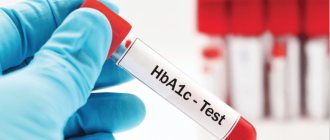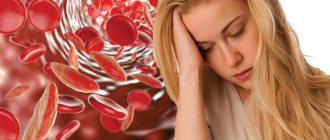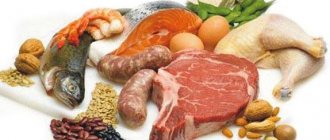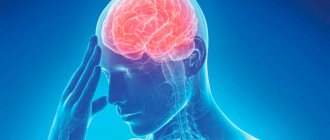Hemoglobin, a protein compound, makes up about 90% of red blood cells (erythrocytes). It is composed primarily of iron and gives blood its red color. Hemoglobin absorbs oxygen from the air entering the lungs, transports it through the bloodstream throughout the body and releases it to tissue cells. There, hemoglobin absorbs carbon dioxide and returns it to the lungs. Without this blood element, normal tissue saturation in both men and women is impossible.
The body produces more than a liter of blood every month. A red blood cell lasts about 112 days before it is broken down by the body. The iron contained in hemoglobin is almost entirely reused to form new red blood cells.
A low hemoglobin (Hb) value indicates that a person's blood is low in iron. In this case, oxygen transport and the formation of new red blood cells are threatened.
Value is normal
The ideal hemoglobin value depends on age and gender. In men, the level is increased, and women aged 60+ more often have a reduced level.
The normal value for a healthy woman after 18 years is from 120 to 160 g/l.
Classification of hemoglobin levels:
| Lightweight | 110-120 g/l |
| Average | 108-110 g/l |
| Heavy | less than 80 g/l |
Hemoglobin 112 in a woman is not always a sign of disease. For some, this is a variant of the norm. The most common consequence of decreased levels is anemia, in which the body does not receive enough oxygen.
Reasons for the decrease to 112 g/l
Hemoglobin may decrease during acute bleeding because the body slows down the production of new red blood cells during this period.
In laboratory conditions, analysis may show a decrease in levels. This occurs with overhydration, which occurs, for example, with excessive administration of intravenous fluids or as part of renal failure.
There are many causes, but iron deficiency is the most common.
A decrease in hemoglobin levels, with or without a decrease in the number of red blood cells, leads to symptoms of anemia.
The development of anemia is promoted by acquired and congenital pathologies:
- Iron deficiency anemia (common in young women).
- Folic acid deficiency or vitamin B12 deficiency.
- Disorders of globin chain synthesis (sickle cell anemia, thalassemia).
- Chronic diseases (cancer, chronic inflammation or infectious diseases).
If the body is not sufficiently supplied with oxygen due to a reduced hemoglobin concentration, this leads to unpleasant symptoms:
- shortness of breath;
- dizziness;
- increased heart rate;
- fatigue;
- pallor of the mucous membranes.
Hemoglobin 112 in a woman, as well as an indicator of 108-110 g/l, is possible in pregnant women, in those who follow a vegetarian diet, or abuse alcohol. Often the level depends on the position in which the patient was during blood sampling. Thus, the lying position reduces the hemoglobin level by 5%.
Symptoms and causes of low hemoglobin
Insufficient hemoglobin content in the blood provokes frequent fatigue, malaise, drowsiness, loss of strength, and bad mood. Patients also complain of constant headache and dizziness. In addition, there is pallor of the skin, poor appetite, tinnitus, cold hands and feet, perversion of taste, pain in the muscles, and the frequent development of colds and viral infections.
In severe cases, the person may lose consciousness. Therefore, in this case, you should definitely visit a doctor and undergo the necessary tests.
Nothing happens for nothing. Including hemoglobin, it cannot decrease without reason. This deficiency in the body is indicated by serious diseases and certain conditions:
- Iron deficiency anemia in chronic form.
- Various bleeding.
- Long-term gastritis.
- Inflammatory bowel pathologies, dysbiosis.
- Time period after surgery.
- Oncology of blood cells.
- Neoplasms in the digestive tract.
- Hepatitis.
- Tuberculosis, pneumonia.
- Iron deficiency.
- Vitamin B12 and folic acid deficiency.
- Destruction of the structure of red blood cells due to severe pathologies.
- Following a diet that involves limiting a large amount of food.
The reasons for a decrease in hemoglobin can be various conditions. However, the greatest impact on protein deficiency is exerted by various blood losses due to surgery, trauma, wounds, and hemorrhoids.
In females, a decrease in hemoglobin most often occurs during menstruation, which lasts more than 5 days.
Diagnostics
A low hemoglobin level indicates a laboratory sign of anemia, which can be caused by various conditions and diseases.
During a blood test, the following parameters are determined:
- Hematocrit It is a measure of red blood cells in relation to the volume of the liquid portion of the blood. It shows how viscous the blood is and what the patient's fluid balance is. Hematocrit in women: lower limit 37%, upper limit – 48%. A decrease is observed with overhydration, blood loss or a decrease in the number of red blood cells.
- MCV shows red blood cell volume (normal or normocytic, too low, microcytic, too high, macrocytic).
- The analysis shows the average hemoglobin content in a red blood cell.
If anemia is suspected, an additional biochemical blood test is prescribed.
Treatment methods
Hemoglobin reduced to 112 g/l is quite common. According to WHO, more than 1.5 billion people suffer from this pathology. And every fifth woman has signs of iron deficiency anemia.
Depending on the causes of anemia, different types of drugs are used to increase hemoglobin levels.
Iron-deficiency anemia
In case of illness, the prescription of iron supplements is mandatory, since it is impossible to eliminate iron deficiency with diet alone. Products containing divalent iron are used, since it is easily absorbed by the gastrointestinal tract.
The daily dosage should be at least 100-300 mg of a drug containing Fe2. Large doses do not make sense, since the amount of iron absorbed by the body is limited. The specific dose is determined by the doctor based on the patient’s condition. Normalization of hemoglobin levels occurs at 7-8 weeks.
Drugs recommended for treatment:
| Aktiferrin | It is used for iron deficiency anemia caused by blood loss, peptic ulcers, lactation and pregnancy. Prescribed 1 capsule 2-3 times/day. |
| Sorbifer Durules | It is recommended to take 2 tablets 2-3 times a day for anemia of various etiologies. |
| Totema | An antianemic drug is prescribed for impaired iron absorption, during lactation, pregnancy, and abnormal menstrual bleeding. Dose: 100-200 mg per day. |
| Ferroplex | Prescribed for iron deficiency and anemia of various origins. Not recommended for aplastic anemia (damage to bone marrow cells), bleeding. Average daily dose: 100-200 mg. |
In some cases, drugs are administered intramuscularly.
Indications for parenteral administration:
- the absorption process is impaired, for example, with pancreatitis, enteritis;
- stomach ulcer;
- ulcerative colitis is nonspecific.
For these cases, medications are provided: Ferrum Lek, Venofer, Ectofer.
If the effect of treatment with iron-containing drugs is low, additional antioxidants, such as vitamin E, are prescribed.
Increased hemoglobin with deficiency of vitamin B12 and folic acid
In this case, iron supplements are not prescribed, and treatment is carried out only after confirmation of the diagnosis of B12-deficiency anemia.
Solutions for intramuscular injections:
- Cyanocobalamin. Used for chronic anemia associated with vitamin deficiency. The drug is administered intramuscularly or intravenously, 1 mg daily for 4-5 weeks. For preventive purposes, 1 mg is administered once a month.
- Oxycobalamin. In case of vitamin deficiency, 0.1 mg is administered once a day. The course of treatment is from 20 to 25 days.
Folic acid preparations are prescribed for diagnosed folate deficiency anemia.
Increase hemoglobin with home remedies
If we talk about mild anemia, then in some cases normalization of nutrition helps eliminate the symptoms.
Hemoglobin 112 in a woman can be raised naturally with the help of foods rich in iron, vitamin B9 and folic acid, which is necessary for the construction of DNA, which is found in all cells of the body. Eating liver, tomatoes, potatoes, and herbs will help with this.
- Vitamin C. Plays an important role in the absorption of iron. Foods high in vitamin C include oranges, grapefruit and lemons, strawberries. Vegetables you should use are peppers, tomatoes, broccoli and spinach.
- Seafood and meat. Recommended products: lamb, veal liver, minced meat, mussels, shrimp, chicken liver.
- Fish. Tuna, catfish, salmon and sardines increase hemoglobin levels.
- Legumes and grains. Chickpeas, beans, peas and lentils are rich in iron, as are wheat, millet and oats.
- Fruits. Bananas and grapes top the list, followed by figs. They significantly increase the level of iron and hemoglobin in the body.
- Vegetables. Some vegetables contain not only vitamin C, but also iron. These include leafy vegetables such as spinach, chard, and beets. Equally important are potatoes with skin, tomatoes and pumpkin.
- Honey. Among the many good properties of honey is its positive effect on the formation of hemoglobin in the body. In addition to iron, honey contains manganese and copper, which also strengthens the immune system.
Many foods remove iron from the body and are therefore counterproductive, so you should avoid:
- soft drinks containing caffeine such as cola;
- coffee, tea containing tannins, which make it difficult for the body to absorb iron;
- foods containing large amounts of calcium, as it reduces iron absorption.
Recipes that increase hemoglobin:
- Almond. Contains a lot of copper, which helps in the production of hemoglobin. Soak 7 almonds in water for 2 hours, remove their thin red skins, and then chop them. Use the paste once a day on an empty stomach.
- Sesame seeds. Put 1 tbsp. l. seeds in a glass of hot water, then grind and filter. Mix ground seeds with warm milk, sugar, take once a day.
- Carrot, orange and beet juice. Peel 2 small beets and 2 carrots, cut into thin slices. Place in a blender along with orange juice and make a smooth drink. Drink daily on an empty stomach. It is recommended to carry out the procedure for 9 days in a row. Then pause for a month and repeat the treatment.
Nettle is one of the medicinal herbs that contains a lot of good iron. It can be used in its pure form (in salad, soup), or made into a smoothie or drink.
Nettle tea recipe:
- Collect a few fresh leaves of young nettles.
- Pour a glass of boiling water.
- Let it brew for 5-7 minutes, then strain.
- Drink, brew like tea, 1 cup, three times a day.
You can increase iron-containing protein using synthetic vitamin complexes or dietary supplements with iron.
Among them, hematogen is of particular importance. The drug Ferrohematogen contains substances, albumin, iron, folic acid, vitamin B9, necessary to replenish iron deficiency.
If the average hemoglobin concentration is reduced to 112 g/l, this does not always mean that the woman is sick. The condition may be caused by recent blood loss or dietary habits. But whatever the reason, you should review your diet and, if necessary, begin therapy.
Is it possible to recognize anemia only by hemoglobin?
Anemia is a disease that reduces the supply of oxygen to the cells and tissues of the body. First of all, the organs that consume oxygen for work - the brain and heart - are affected. Any general blood test must include hemoglobin, the oxygen carrier. It would seem that this is enough to identify anemia. The degree of anemia is determined by the decrease in hemoglobin. Why do doctors prescribe additional blood tests?
The most common is iron deficiency anemia. After all, 60% of iron is in hemoglobin. If there is not enough iron, then less hemoglobin is formed and anemia develops. Iron deficiency is associated with reduced consumption of meat and other iron-containing foods, blood loss, injury, periods of increased iron consumption during growth in children, pregnancy, and physical activity.
It often happens that pallor, weakness, and fatigue accompany infectious or long-term diseases. These symptoms are not always manifestations of the disease. Anemia of inflammation (chronic diseases) is the second most common after iron deficiency anemia. It can be caused by infectious and non-infectious chronic diseases. For example, long-term viral, bacterial, parasitic infections, chronic kidney diseases and autoimmune inflammation of the joints, intestines, and connective tissue.
How to find out what caused anemia?
First of all, iron deficiency is excluded, when there is not enough incoming iron or it is lost too quickly. Iron deficiency occurs before anemia because iron is consumed from tissue reserves - ferritin. Serum ferritin levels below 30 μg/L are the first sign of iron depletion in the body. Anemia does not appear immediately, sometimes only when ferritin drops below 12-15 mcg/l.
A decrease in ferritin is a sign of iron deficiency. As well as increasing the total iron-binding capacity of serum (TIBC).
In anemia of inflammation, one of the inflammatory proteins prevents iron from being absorbed from the intestines and does not release it from the depot. Other inflammatory products interfere with the formation of young red blood cells in the bone marrow and shorten their life (red blood cells live about 120 days). Anemia develops within 2 weeks after the onset of severe inflammation. Since iron is not depleted from the reserve, serum ferritin levels will be normal. It even increases, because ferritin is also an inflammatory protein. What if iron deficiency is combined with anemia of chronic diseases? Ferritin alone is not enough to determine the cause of anemia. Therefore, it is worth thinking about iron deficiency if, against the background of inflammation (increased C reactive protein more than 10 mg/l), ferritin is below 50 μg/l.
During inflammation, acute inflammatory proteins, such as C reactive protein, increase in the serum, and ferritin may be normal or elevated.
What to pay attention to:
Anemia of inflammation (chronic diseases) can be suspected if:
- anemia occurred against the background of an acute or chronic inflammatory disease;
- erythrocyte indices (MCV, MCH, MCHC, RDW) in the general blood test are practically unchanged;
- serum ferritin level is normal or elevated;
- Taking iron supplements for 4 weeks does not lead to an increase in hemoglobin.
Table 1 presents the diagnostic criteria for iron deficiency anemia and anemia of chronic inflammation.
| Indicators | Iron-deficiency anemia | Anemia of chronic inflammation |
| Having a chronic disease | No | Eat |
| Serum iron | Decrease <12.5 µmol/l | Possible decrease <12.5 µmol/l |
| OZhSS | Increase >69 µmol/l | Within reference values |
| NTZH | <17% reduction | Within reference values |
| Ferritin | <12.5 µg/L (<30 µg/L for latent iron deficiency without anemia) | Within the reference values or increased (with CRP >10 mg/l and ferritin <50 μg/l, iron deficiency is possible) |
Table 1. Criteria for diagnosing iron deficiency anemia and anemia of chronic inflammation.
Necessary tests to detect iron deficiency and anemia of inflammation (chronic diseases):
- General blood analysis
- Ferritin
- C-reactive protein
- OZhSS
In the Lab4U online laboratory, all tests can be taken with a discount of up to 50%.
In accordance with the “Federal clinical guidelines for the diagnosis and treatment of anemia of chronic diseases in children.” Public organization National Society of Pediatric Hematologists and Oncologists; FSBI "FNKTs DGOI im. Dmitry Rogachev" of the Ministry of Health of Russia. - Moscow, 2015
In accordance with the “Federal Clinical Guidelines for the Diagnosis and Treatment of Iron Deficiency Anemia.” Public organization National Society of Pediatric Hematologists and Oncologists; FSBI "FNKTs DGOI im. Dmitry Rogachev" of the Ministry of Health of Russia. - Moscow, 2014










